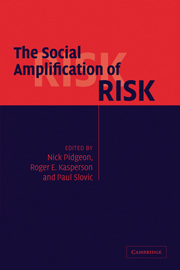Book contents
- Frontmatter
- Contents
- List of figures
- List of tables
- List of contributors
- Acknowledgments
- Introduction
- Part I Conceptual foundations
- 1 The social amplification of risk: assessing fifteen years of research and theory
- 2 The logical structure of the social amplification of risk framework (SARF): Metatheoretical foundations and policy implications
- 3 Social amplification of risk and the layering method
- 4 Institutional failure and the organizational amplification of risks: the need for a closer look
- Part II Risk signals and the mass media
- Part III Public perceptions and social controversy
- Part IV Risk ripples and stigma effects
- Part V Policy and management
- Bibliography
- Index
1 - The social amplification of risk: assessing fifteen years of research and theory
Published online by Cambridge University Press: 06 July 2010
- Frontmatter
- Contents
- List of figures
- List of tables
- List of contributors
- Acknowledgments
- Introduction
- Part I Conceptual foundations
- 1 The social amplification of risk: assessing fifteen years of research and theory
- 2 The logical structure of the social amplification of risk framework (SARF): Metatheoretical foundations and policy implications
- 3 Social amplification of risk and the layering method
- 4 Institutional failure and the organizational amplification of risks: the need for a closer look
- Part II Risk signals and the mass media
- Part III Public perceptions and social controversy
- Part IV Risk ripples and stigma effects
- Part V Policy and management
- Bibliography
- Index
Summary
The social amplification of risk framework in brief
More than a decade has elapsed since the introduction in 1988 of the social amplification of risk framework (SARF) by researchers from Clark University (Kasperson, Kasperson, Renn, and colleagues) and Decision Research (Slovic and colleagues). During that time various researchers have enlisted the framework to complete a substantial number of empirical studies. All the while, the emergence of a much larger body of relevant knowledge has spawned a lively debate on aspects of the framework. In this chapter we consider these developments, inquiring into refinements, critiques, and extensions of the approach, the emergence of new issues, and the findings and hypotheses growing out of fifteen years of empirical research.
The theoretical foundations of SARF are developed in five principal publications (Kasperson, Renn, Slovic et al. 1988; Renn 1991a; Kasperson 1992; Burns et al. 1993; Kasperson and Kasperson 1996). The idea arose out of an attempt to overcome the fragmented nature of risk perception and risk communication research by developing an integrative theoretical framework capable of accounting for findings from a wide range of studies, including: from media research; from the psychometric and cultural schools of risk perception research; and from studies of organizational responses to risk. The framework also serves, more narrowly, to describe the various dynamic social processes underlying risk perception and response. In particular, those processes by which certain hazards and events that experts assess as relatively low in risk can become a particular focus of concern and sociopolitical activity within a society (risk amplification), while other hazards that experts judge more serious receive comparatively less attention from society (risk attenuation).
- Type
- Chapter
- Information
- The Social Amplification of Risk , pp. 13 - 46Publisher: Cambridge University PressPrint publication year: 2003
- 237
- Cited by



